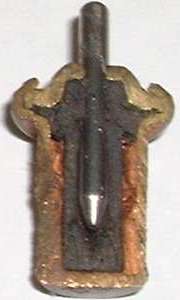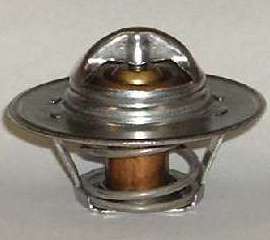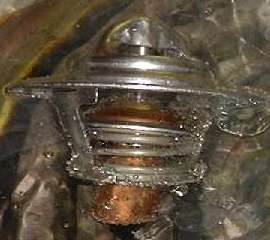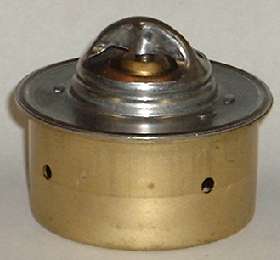The MGA With An Attitude
THERMOSTAT, MODERN TYPE With No Sleeve - CO-103C
 On the right is a picture (bigger than life) of a cutaway section of a "Power Pill" actuator removed from a modern thermostat. The copper colored substance lining the inside of the cylindrical shell is a phase change material. At the appropriate temperature the volatile component of this "stuff" changes from a solid state to a gaseous state at very high pressure. This may be up to a few hundred psi, because the end of the rod (0.150 inch diameter) is all the piston area that the stuff is pushing against. There is a thick but soft rubber seal/diaphram surrounding the center push rod (which is chrome plated and polished). The high internal pressure pushes inward on the sides and bottom of the rubber diaphram to force the puhrod to extend out of the "pill" with several pounds of force to move the valve, working against a spring in the thermostat. When temperature drops enough to allow the phase change material to condense, spring force pushes the actuator rod back into the power pill.
On the right is a picture (bigger than life) of a cutaway section of a "Power Pill" actuator removed from a modern thermostat. The copper colored substance lining the inside of the cylindrical shell is a phase change material. At the appropriate temperature the volatile component of this "stuff" changes from a solid state to a gaseous state at very high pressure. This may be up to a few hundred psi, because the end of the rod (0.150 inch diameter) is all the piston area that the stuff is pushing against. There is a thick but soft rubber seal/diaphram surrounding the center push rod (which is chrome plated and polished). The high internal pressure pushes inward on the sides and bottom of the rubber diaphram to force the puhrod to extend out of the "pill" with several pounds of force to move the valve, working against a spring in the thermostat. When temperature drops enough to allow the phase change material to condense, spring force pushes the actuator rod back into the power pill.
Pat Jenkins is a thermostat engineer for Robertshaw.
At 12:08 AM 10/20/04 +0000, Pat Jenkins wrote:
>"The actuators used in modern thermostats are all very similiar. Robertshaw's is called a Power Pill. The phase change material is a mixture of petroleum based wax, heat transfer media, and a few special secret ingrediants. The heat transfer media is usually copper powder, though some manufactures use other powders".
The top opening of this newer type thermostat is just over 1 inch diameter, again giving a flow area of about 0.8 sq.in. This provides as much flow in the MG as the moving ring thermostat, and it has worked well for decades in small block Chevy V8's and other engines much larger than the MG engines.
 
The important thing here is that the newer type thermostat does not have the moving ring around the base, so it does not cover the bypass port in the head when it opens. This means that when the engine is running at elevated temperatures some of the coolant can always be bypassing the radiator and recirculating back into the engine at full temperature. This can cut into the cooling capacity a little, and under very marginal conditions even a little bit can make a substantial difference in running temperature (overheating).
 Now there is a fix for the problem of using the newer type thermostat in an engine with a bypass port in the head. You drop the blanking sleeve into the head first, then drop the new type thermostat into the blanking sleeve. The blanking sleeve of course covers the bypass port at all times, and you still need a little coolant circulation when the engine is warming up. The fix for this is to drill a 3/16" diameter hole in the outer flange of the thermostat to allow a little coolant to pass through the radiator during warm up time. If the thermostat you are using happens to have a small air-relief poppet valve in the top, you can just remove the poppet and leave the hole open. This small amount of coolant circulating through the radiator will extend the engine warm up period slightly, but you will probably never notice the difference. Once it's up to running temperature and the thermostat begins to open it will effectively regulate the minimum operating temperature in the same manner as originally intended.
Now there is a fix for the problem of using the newer type thermostat in an engine with a bypass port in the head. You drop the blanking sleeve into the head first, then drop the new type thermostat into the blanking sleeve. The blanking sleeve of course covers the bypass port at all times, and you still need a little coolant circulation when the engine is warming up. The fix for this is to drill a 3/16" diameter hole in the outer flange of the thermostat to allow a little coolant to pass through the radiator during warm up time. If the thermostat you are using happens to have a small air-relief poppet valve in the top, you can just remove the poppet and leave the hole open. This small amount of coolant circulating through the radiator will extend the engine warm up period slightly, but you will probably never notice the difference. Once it's up to running temperature and the thermostat begins to open it will effectively regulate the minimum operating temperature in the same manner as originally intended.
|